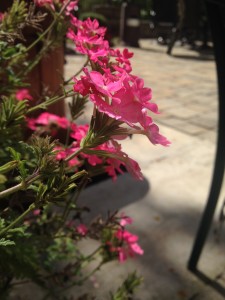My backyard has a wide variety of plant life. Let’s take a look and see what I found!

Primula laurentiana
Common Name: Bird’s-eye Primrose
Plant Family: Primulaceae
Introduced to Ohio, native to the Northeastern United States
Field Notes: The pink Bird’s-eye Primrose depicted below was identified on September 14, 2014 in Hudson, Ohio. The habitat was a cultivated lawn with scattered, planted trees. The soil was rich with nutrients to encourage the flowering of this plant. The yellow eye within the flower along with the umbel arrangement helped to identify this plant.

Nodding Wild Onion collected in Hudson, OH
Allium cernuum
Common Name: Nodding Wild Onion
Family: Liliaceae
Native to Ohio
Field Notes: This white Nodding Wild Onion was identified near a rock retaining wall in a cultivated lawn in Hudson, Ohio on September 14, 2014. The soil was rich, moist, and provided excellent drainage for this plant. Helpful characteristics used to identify this plant include the small, white (or purple) flowers that grow in an umbel, or originating from one central point of growth. The smell of onion might be the most crucial piece of information in identifying this plant, the raw onion smell will be the most intense within the leaves. The leaves have a parallel venation pattern, meaning that the veins of the leaves are running in straight lines from the bottom of the leaf to its apex. Lastly, the “nodding” is a result of the curvature of the flower stem near the umbel.

Black-eyed Susan collected in Hudson, OH
Rudbeckia hirta
Common Name: Black-eyed Susan
Family: Asteraceae
Native to Ohio
Field Notes: This Black-eyed Susan was found near the bottom of a man-made hill in an overgrown, cultivated lawn in Hudson, Ohio on September 14, 2014. The soil was moist to moderately wet. This flower is distinguished by its large black head and yellow petals.
Works Cited
Newcomb, Lawrence. Newcomb’s Wildflower Guide: The Classic Field Guide for Quick Identification of Wildflowers, Flowering Shrubs and Vines. Boston: Little, Brown, 1977. Print.
“Plants Profile for Allium Cernuum (nodding Onion).” Plants Profile for Allium Cernuum (nodding Onion). United States Department of Agriculture, n.d. Web. 17 Sept. 2014.
“Plants Profile for Primula Laurentiana (birdeye Primrose).” Plants Profile for Primula Laurentiana (birdeye Primrose). United States Department of Agriculture, n.d. Web. 17 Sept. 2014.
“Plants Profile for Rudbeckia Hirta (blackeyed Susan).” Plants Profile for Rudbeckia Hirta (blackeyed Susan). United States Department of Agriculture, n.d. Web. 17 Sept. 2014.

























